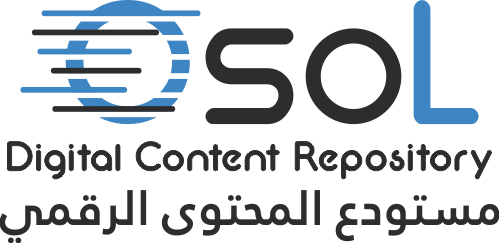Please use this identifier to cite or link to this item:
https://dspace.qou.edu/handle/194/2834Full metadata record
| DC Field | Value | Language |
|---|---|---|
| dc.contributor.author | Mansor, Amneh | - |
| dc.date.accessioned | 2024-10-14T07:27:41Z | - |
| dc.date.available | 2024-10-14T07:27:41Z | - |
| dc.date.issued | 2022-09-18 | - |
| dc.identifier.uri | https://dspace.qou.edu/handle/194/2834 | - |
| dc.description.abstract | The study examines the relationship between internal communication and organizational culture through measuring the impact of digitization on the internal communication process in the context of the media institution. The study is based on a theoretical framework that links the technological determinism theory and the structural-functional theory, and the concept of interactivity in new media, in addition to the concepts of organizational culture and internal communication which are coming from the field of management as a guiding theoretical framework for study. In achieving its goals, this mixed study is based on a constructivist philosophy methodology, using a case study approach. It relies on sequential mixed research, employing the interview and survey questionnaire tools as data collection tools. The study sought to answer the question: How do internal communication digitization processes affect the form of organizational culture in the Palestinian official media institutions? The study population consists of staff and all departments of the official Palestinian media institutions, which are the Palestinian Broadcasting Corporation, Al Hayat Newspaper and the Palestinian News and Info Agency "Wafa" -all based in city of Ramallah, Palestine. The study depends on a stratified random sampling from the study population in each institution. The questionnaire was distributed on the number of samples that fit the size of the study population represented by workers in the departments working in official media institutions, with a percentage of 5% of the error, as follows: the Palestinian Broadcasting Corporation (371), and the Palestinian News and Info Agency “Wafa” (58), Al-Hayat Al-Jadida Newspaper (32). The study concluded that the overall average of all study aspects came to a high degree, which indicates that there is an impact of digital communication on the form of organizational culture within Palestinian official media institutions. The study found that Palestinian official media institutions strive to employ digital communication tools, and this is reflected on the organizational culture within the institution. They have achieved a qualitative leap in the process of digital transformation in this field, despite the limitations that prevent a full realization of the process of digitizing their internal communication tools. The study recommends the necessity of developing a strategic plan to digitize the internal communication in the media institutions, developing the communication network within the institution, qualifying and developing the human cadres working in them. | en |
| dc.language.iso | ar | en |
| dc.publisher | Al-Quds Open University | en |
| dc.subject | communication | en |
| dc.subject | internal communication | en |
| dc.subject | organizational culture | en |
| dc.subject | digitization | en |
| dc.subject | media institution | en |
| dc.subject | media management | en |
| dc.subject | اتصال | en |
| dc.subject | اتصال داخلي | en |
| dc.subject | ثقافة تنظيميّة | en |
| dc.subject | رقمنة | en |
| dc.subject | مؤسسة إعلاميّة | en |
| dc.subject | إدارة المؤسسات الإعلاميّة | en |
| dc.title | Impact of Digitizing Internal Communication on Formulating Organizational Culture of Media Institutions. A Case Study: Palestinian Official Media Institutions | en |
| dc.type | Thesis | en |
| dc.description.arAbstract | تبحث هذه الدّراسة في العلاقة بين الاتصال والثّقافة التنظيميّة من خلال قياس تأثير عمليات الرقمنة في الاتصال الداخلي في سياق المؤسسة الإعلاميّة، مستندة على إطار نظري يربط بين نظريتيّ الحتميّة التكنولوجيّة والوظيفيّة البنائيّة، ومفهوم التفاعليّة في الإعلام الجديد، إضافة الى مفهوميّ الثّقافة التنظيميّة والاتصال الدّاخلي القادمين من حقل الإدارة كإطار نظري موجّه للدراسة. وتستند هذه الدّراسة المختلطة في تحقيق أهدافها على أحد أشكال البحث القائم على الفلسفة البنائيّة، وهو دراسة الحالة "Case Study"، فيما اعتمدت على البحث المختلط التسلسلي، موظفة أداتي المقابلة واستطلاع الرأي، حيث سعت الدّراسة إلى الإجابة على السؤال: كيف تؤثر عمليات رقمنة الاتصال الدّاخلي على شكل الثّقافة التنظيميّة في مؤسسات الإعلام الرّسمي الفلسطيني؟ يتكون مجتمع الدّراسة من الطواقم والأقسام العاملة في مؤسسات الإعلام الرّسمي الفلسطيني، وهي هيئة الإذاعة والتلفزيون الفلسطيني، وجريدة الحياة الجديدة، ووكالة الأنباء والمعلومات الفلسطينيّة "وفا" في مدينة رام الله. تعتمد الدّراسة على العيّنة الطبقيّة البسيطة من مجتمع الدّراسة في كل مؤسسة، حيث تمّ توزيع الاستبانة على عدد العينات التي تناسب حجم مجتمع الدّراسة المتمثل في العاملين في الأقسام العاملة في مؤسسات الإعلام الرّسمي، وبنسبة 5% من الخطأ، على النّحو الآتي: هيئة الإذاعة والتلفزيون (371) مفردة، وكالة الأنباء والمعلومات الفلسطينية "وفا" (58) مفردة، جريدة الحياة الجديدة (32) مفردة توصلت الدّراسة إلى أنّ المتوسط الكلي لجميع محاور الدّراسة جاءت بدرجه مرتفعة، ما يشير إلى أنّ هناك تأثير للاتصال الرّقمي على شكل الثّقافة التنظيميّة داخل المؤسسات الرّسمية الإعلاميّة الفلسطينيّة. ووجدت الدّراسة أيضا أن مؤسسات الإعلام الرّسمي الفلسطيني تسعى جاهدة إلى توظيف أدوات الاتصال الرّقمي، إذ ينعكس ذلك على الثّقافة التنظيميّة داخل المؤسسة، حيث حققت نقلة نوعيّة في عمليّة التحوّل الرّقمي في هذا المجال، على الرغم من المحددات التي تحول دون تحقيقٍ كامل لعمليّة رقمنة أدوات الاتصال الدّاخلي فيها. توصي الدّراسة بضرورة وضع خطّة استراتيجيّة لرقمنة الاتصال الدّاخلي في المؤسسات الإعلاميّة وتطوير شبكة الاتصال داخل المؤسسة، وتأهيل وتطوير الكوادر البشريّة العاملة فيها بما يتوافق مع متطلبات واحتياجات الرقمنة. | en |
| dc.contributor.arAuthor | منصور, آمنة | - |
| dc.arTitle | أثر رقمنة الاتصال الدّاخلي على شكل الثّقافة التنظيميّة في المؤسسات الإعلاميّة دراسة حالة: مؤسسات الإعلام الرّسمي الفلسطيني | en |
| Appears in Collections: | ماجستير إدارة المؤسسات الإعلامية - Management of Media Institutions | |
Files in This Item:
| File | Description | Size | Format | |
|---|---|---|---|---|
| رسالة آمنة منصور بعد التعديلات.pdf | 2.56 MB | Adobe PDF | View/Open |
Items in DSpace are protected by copyright, with all rights reserved, unless otherwise indicated.
